Picture a gathering of scholars in, let’s say, the 7th century CE, somewhere in the British Isles. They’ve convened to give a proper Olde English name to a kind of small, sweet red berry that grows wild during the summer. The berries are unspeakably delicious, juicy, and sweet, with a hue that causes poets to write bad verses about lips and love and their true heart’s delight.
With a berry like that, you’d expect them to come up with something a little more inspiring than, say, “straw berry.” I can’t think of a more bland description. Straw isn’t exactly known for its flavor. Yet that’s the name they settled on, “straw,” in this case likely referring to the Old English meaning of “to spread or scatter,” a quality of strawberries owed to their small seeds.
But luckily, the flavor and color of these berries have overcome this early marketing mistake. Over the centuries, the bright scarlet (although some are also pink and white) fruits have inspired odes, served as metaphors for painters, and delighted eaters of all ages. These days, the strawberry is the US’s most popular berry, both by volume and dollars spent. And its popularity has reached worldwide proportions.
Ninety percent of the strawberries grown in the US come from California, including many varieties that were first cultivated — and then patented — by the University of California at Davis. While most strawberries are consumed in the US or China, a large amount of US-grown berries end up in Canada. The US also imports fresh strawberries from Mexico, with the amount reaching a record high of 431 million pounds in 2020.
As a proponent of more plant-based eating, I should be cheering wholeheartedly for the strawberry’s massive popularity. Of all the foods you can eat, berries are some of the healthiest — I wrote a whole chapter about them in FRN’s cookbook Real Superfoods. They’re also incredibly tasty and are often used in healthy, fruit-based desserts.
But there are problematic aspects to strawberries as well. They’re quite labor-intensive to produce, and that labor is often done under conditions that are hazardous for farmworkers.
Strawberries also top the list of pesticide-contaminated produce, which is a problem for consumers as well as farmworkers.
So are strawberries still good to eat? Or do their downsides outweigh their benefits? Let’s take a look at the facts about strawberries.
Strawberry Nutrition Facts

First, let’s examine what a strawberry’s nutrient profile looks like.
A cup of sliced strawberries will deliver roughly 53 calories, almost all of which come from carbohydrates. You’ll also get a decent 3.3 grams of fiber, a bit of fat, and a tad over a gram of protein.
Strawberries are a good source of folate and vitamin C, as well as essential minerals like manganese, copper, and potassium.
Strawberries, like other red foods (no, I don’t mean Twizzlers and Jell-O), get their red hue from high concentrations of polyphenols and antioxidants. And according to a not-exactly-scintillating 2017 article published in the Food Quality and Safety Journal, they’re also rich in ellagic acid, which has “antioxidant, anti-inflammatory, antidiabetic, cardioprotective, neuroprotective, and prebiotic effects.”
What Are Strawberries Good For?
Let’s unpack those purported health benefits of strawberries with a quick dive into the research behind these claims.
Are Strawberries Good for Your Heart?
The compounds in strawberries can protect your heart. A 2021 study worked with adult volunteers who showed symptoms of metabolic syndrome but weren’t taking lipid-lowering medication. The volunteers were randomly divided into three groups: One was given a small dose (13 grams) of strawberry powder every day, another was given a larger dose (32 grams) per day, and the third group was given a placebo.
The results showed that just four weeks of consuming either the small or large dose of strawberry powder helped increase the body’s antioxidant levels. The larger dose also reduced markers related to inflammation and poor blood vessel function.
A 2023 study looked at the effects of freeze-dried strawberry powder consumption on heart health. Researchers found that 26 grams per day of the strawberry powder reduced systolic blood pressure and boosted total antioxidant capacity. Both of these are known to lower overall cardiovascular risk.
Another 2023 study replicated the 2021 study of low- and high-dose strawberry powder, and, this time, looked more closely at the mechanisms through which the dried berries improved cardiovascular health. The until-then mysterious target pathways turned out to include a couple of branch chain amino acids, as well as benzoic acid and hydroxyphenyl propionic acid. (If that last sentence makes you hungry for more details, you can read the entire sparkling article online for free here.)
Strawberries and Diabetes
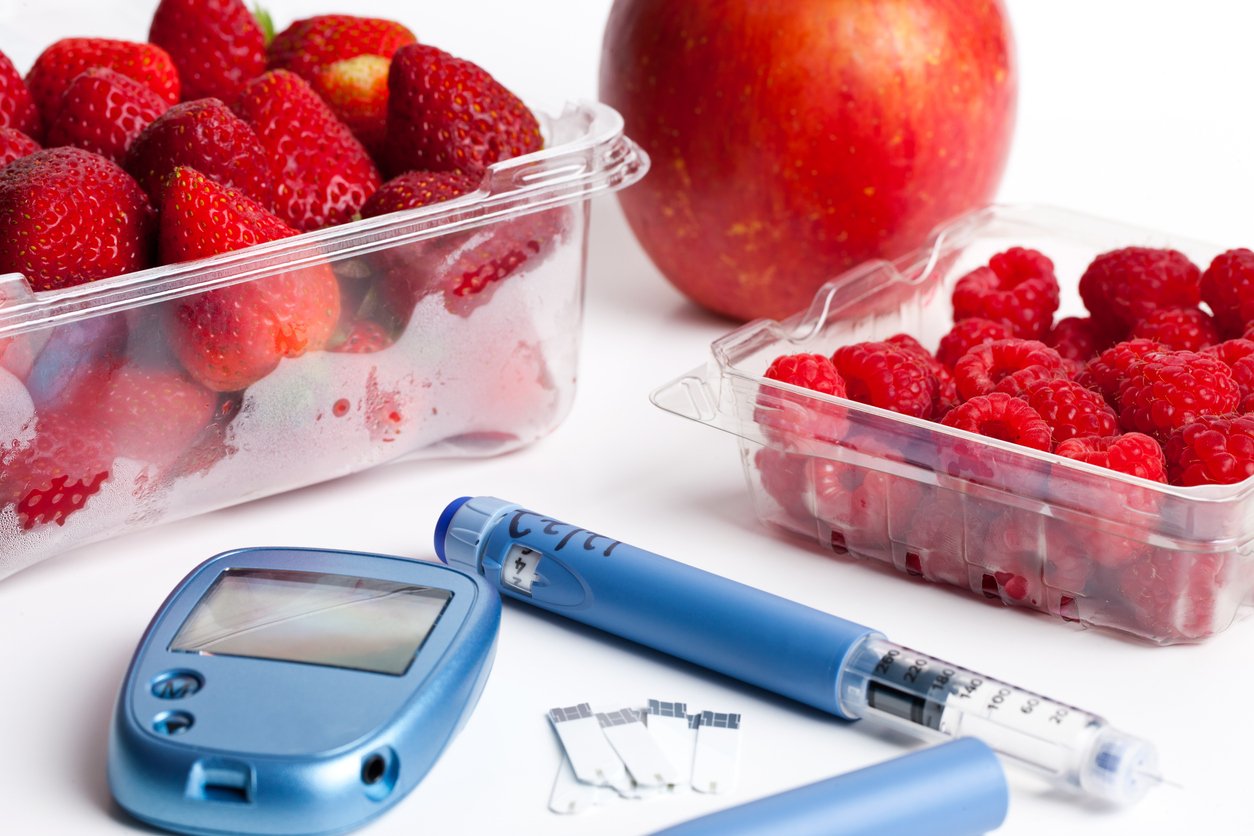
At first glance, you might not think that sweet fruits can prevent or help manage diabetes, a disease characterized by high blood sugar levels. But like many other berries, strawberries have been shown to help people with high insulin resistance (a marker for type 2 diabetes) lower their blood glucose after eating, as well as reduce insulin spikes.
And just in case you were wondering — “Gee, strawberries seem great for humans with type 2 diabetes, but what about rodents?” — science has you covered as well. A 2023 study found that strawberry fruit extract lowered blood sugar levels in diabetic rats, which may also translate to human subjects. (Our view on the use of animals in medical research is here.)
Are Strawberries Good for Your Brain?
According to a randomized, crossover, double-blind, placebo-controlled clinical trial published in 2023, an ounce of strawberry powder a day made older people smarter. Specifically, the researchers found that it could increase processing speed and enhance episodic memory (the kind of memory that does things like remember what you had for breakfast or who sat next to you in third grade).
Another 2023 study of overweight middle-aged men and women who suffered from “subjective cognitive decline” (that is, they self-reported feeling less sharp than previously) also found that 12 weeks of strawberry powder reduced a phenomenon known as “memory interference.” In other words, they were less likely to experience older memories blocking the formation of newer ones.
The strawberry powder also lowered the participants’ likelihood of experiencing symptoms of depression.
Strawberries and Inflammation

One of the things that often happens to obese people is that they develop osteoarthritis, especially in weight-bearing joints like knees. Obesity can increase inflammation (that’s what the “itis” in arthritis means) as well as put extra pressure on the joints that have to hold up the extra weight.
A 2017 study of 17 obese people with osteoarthritis of the knees gave participants either a strawberry-containing beverage or a placebo beverage for 12 weeks and measured a bunch of markers related to pain and inflammation. The researchers found that people who drank the strawberry beverage had lower levels of certain inflammatory markers in their blood. They also reported less pain and better ability to do daily activities compared to when they drank the control beverage.
Strawberries appear to reduce inflammation by suppressing the signaling of a protein called (get ready for it!) nuclear factor kappa-light-chain-enhancer of activated B cells, which sounds like it came right out of a superhero movie, but which can, thankfully, be abbreviated as NF-κB. This protein may contribute to the kinds of chronic stress that lead to inflammation. Strawberries also downregulate the signaling of TLR4 (another element of the immune system that can increase inflammation) and increase the activity of Nrf2 (which helps antioxidant response to inflammation).
Strawberries and Cancer
A 2012 study found that strawberry extract was able to extend the life of mice with breast cancer by slowing tumor formation and causing cancer cells to self-destruct (a process known as apoptosis).
Four years later, another study showed that a polyphenol-rich extract of strawberries decreased the viability of invasive breast cancer cells, both in test-tube studies and in mice.
You may have noticed that the studies on the health effects of strawberries don’t seem to give actual strawberries to their participants, preferring instead freeze-dried powder or some kind of extract. The main reason for that is so the researchers can precisely control the quantities of various compounds in the strawberries.
One problem with using extracts, however, is that some chemicals in strawberries aren’t extractable. A 2022 study found that certain non-extractable phenols from strawberries protected cells in test tubes against colon cancer. This suggests, at least to me, that the benefits of eating whole strawberries probably are underestimated by the studies we’ve looked at here.
The Downsides of Strawberry Production
Despite all these impressive health benefits, there are downsides to strawberries, too — both for individuals who eat them, and for the planet.
Plastic Proliferation
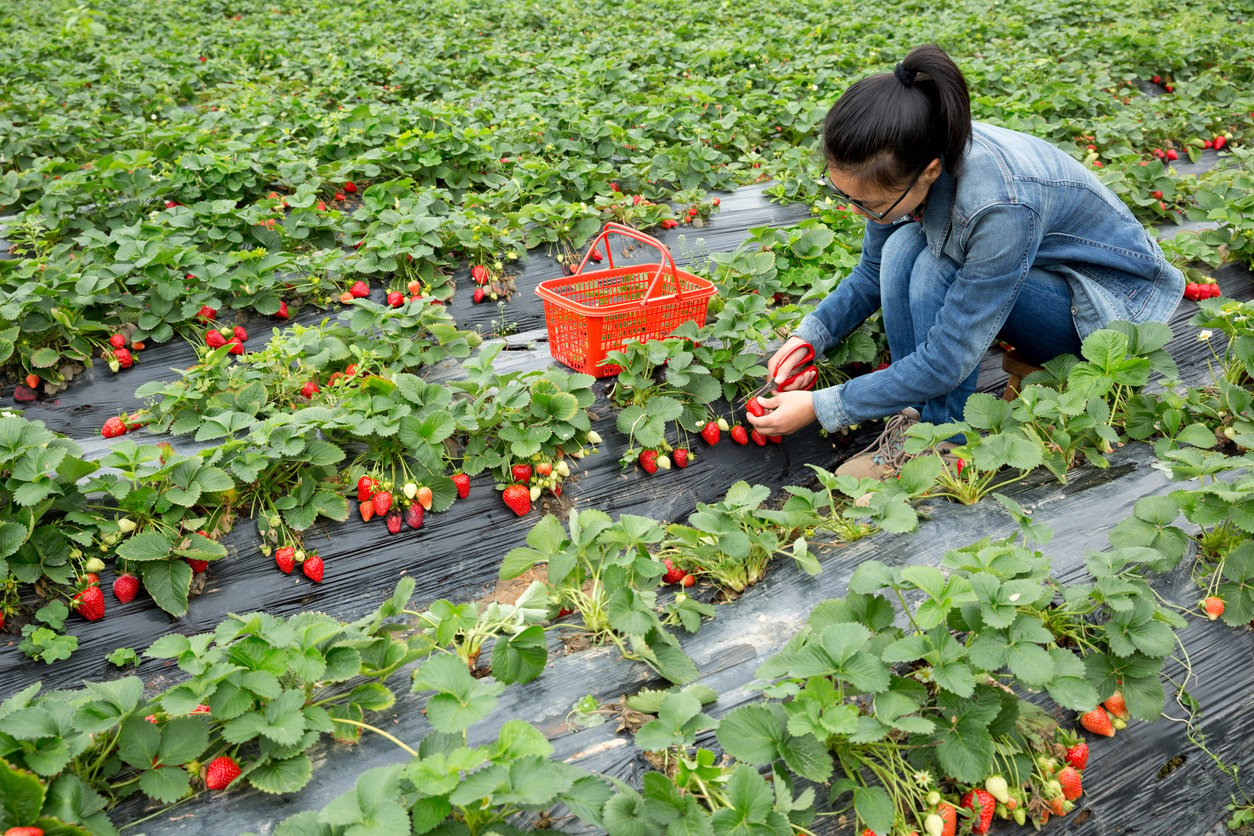
One problem with commercial strawberry production is the amount of plastics used. Both conventional and organic growing may use disposable plastic mulching to keep the berries from rotting when they make contact with the soil.
And the single-use plastic doesn’t end once the berries are harvested. Strawberries are typically sold in plastic clamshell containers that may or may not be recyclable through your local recycling program. This is especially important at a time when microplastics are being found throughout the human body and in almost all of the world’s ecosystems.
To learn ways to cut down on plastic usage, check out Is a Plastic-Free Lifestyle Possible? Tips for Reducing Your Plastic Footprint.
Farmworker Conditions on Strawberry Fields
Strawberry growing can be hazardous to the workers tasked with caring for and harvesting the berries. Nonorganic strawberries get doused in a lot of pesticides, creating a toxic environment for farmworkers and their families.
Even organic methods can be physically demanding and lead to harm. The extreme heat experienced in California and Florida strawberry fields can range from unpleasant to downright dangerous to workers’ health. And the ergonomically compromised posture from constantly bending over to reach the low-growing fruit can cause work-related musculoskeletal disorders.
Picking strawberries is also generally low-paying work, with most of the laborers paid piecemeal at what ends up being little more than minimum wage.
Pesticides on Strawberries
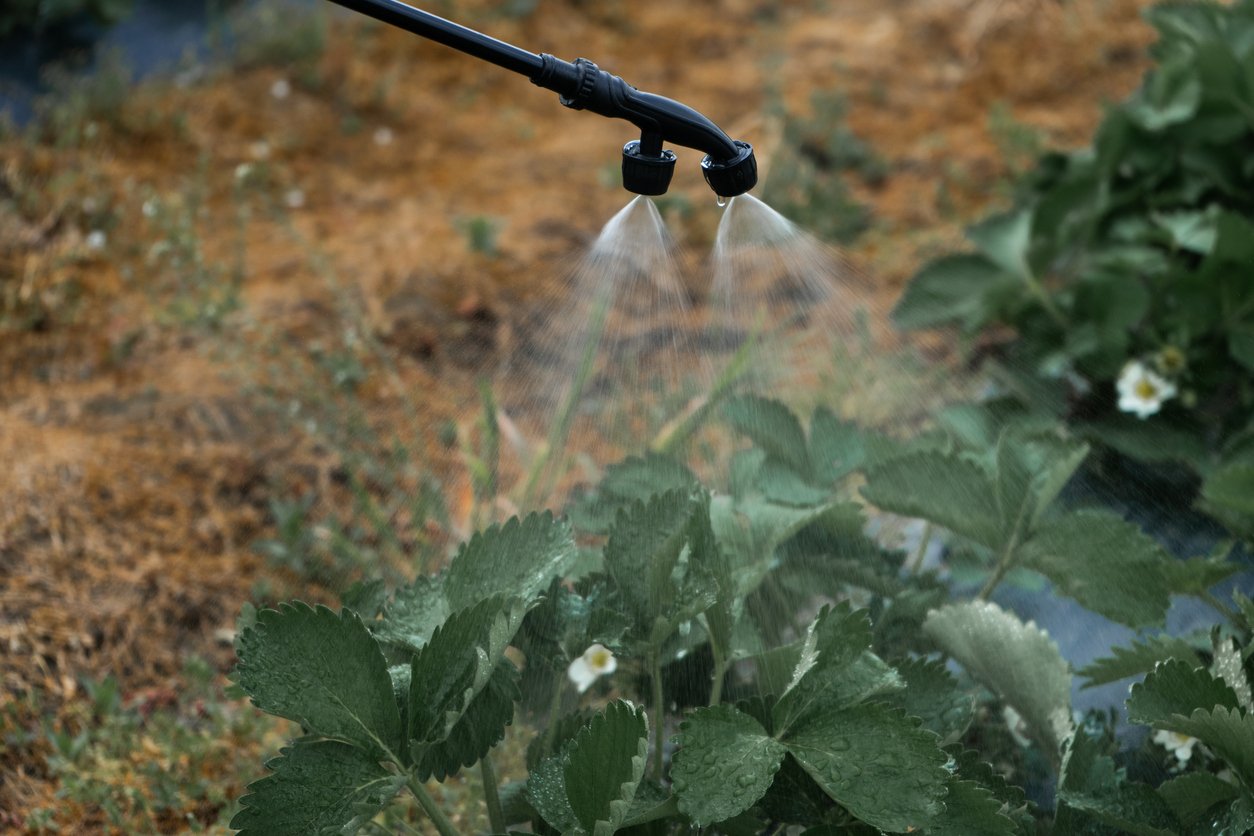
Conventionally grown strawberries have some of the worst pesticide contamination of any produce. Growers routinely apply thousands of pounds of pesticides to their fields, which are typically located in low-income areas, sometimes near schools and homes. The inhabitants of these communities may experience higher concentrations of pesticide biomarkers in blood and urine, increasing their risk of cancer and other diseases.
If you do eat conventionally grown strawberries, you can mitigate your own personal exposure significantly by soaking them in a mixture of water and baking soda. Here’s the best way to wash fruits and vegetables to remove pesticides.
And, of course, this is all a great reason to look for organic strawberries whenever possible.
Food Safety
Another reason to wash your strawberries — conventional or organic — is that they can become contaminated via soil and water. The plants grow low to the ground and are exposed to runoff from animal agriculture (here, “runoff” is a sanitized word for “water that’s contaminated with animal excrement”). In recent years, strawberries have been associated with food recalls related to foodborne illnesses like E. coli O157:H7, norovirus, and hepatitis A.
When Is Strawberry Season?
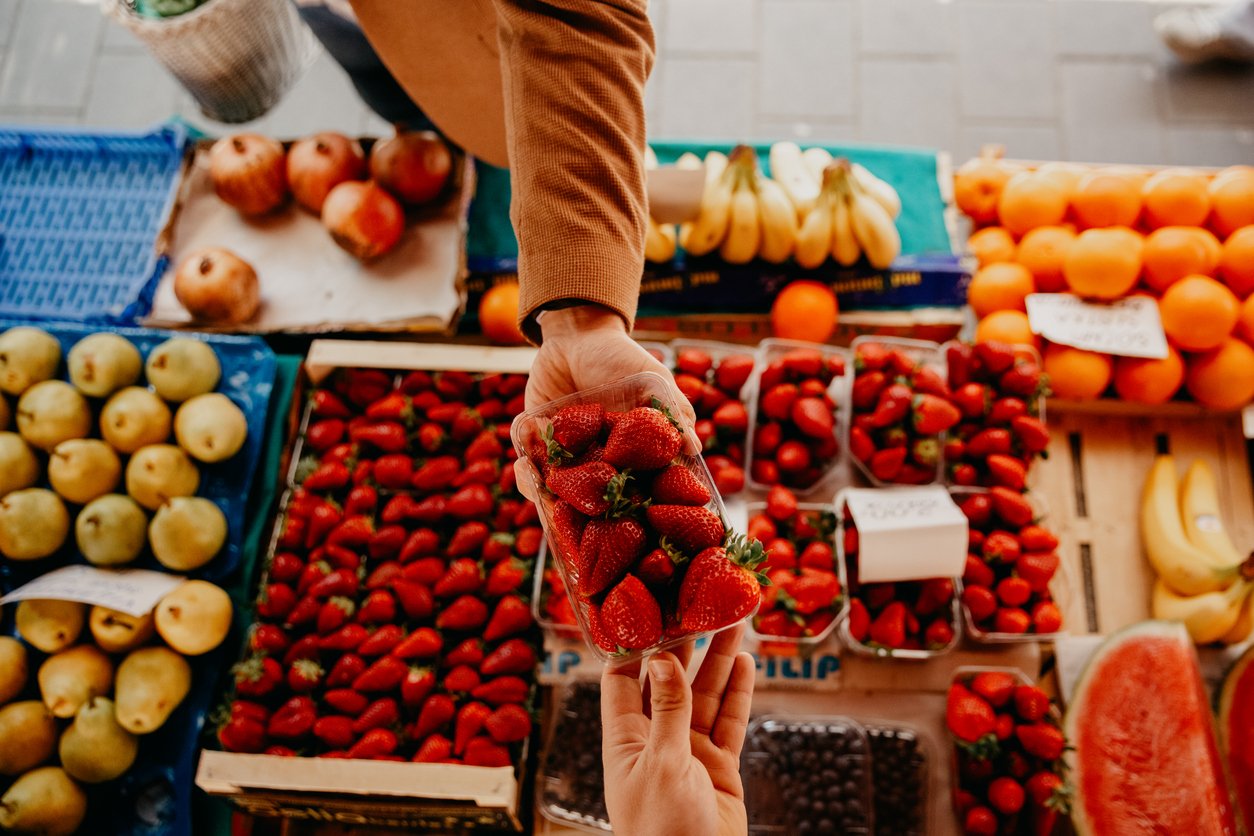
Strawberries are generally available year-round in the US and many other parts of the world, but are better for you and more environmentally friendly if you buy them in season (that is, during the warmer months).
They’re highly perishable, as you may know. But this means that when they’re out of season, your fresh strawberries are probably coming on a large truck, cargo ship, or airplane from hundreds or even thousands of miles away. That’s a hefty carbon footprint.
The exact dates of strawberry season depend on the variety of the berry. June-bearing strawberries are the ones most commonly planted. And, as you might expect from the name, produce a single large harvest in early summer.
Day-neutral berries will give you multiple harvests from June through October in the northern hemisphere. Everbearing varieties provide two harvests of large berries, one in June and the other in the fall. And Alpine strawberries produce fruit all year round, albeit much smaller ones than what you’d find in a supermarket.
These three varieties — June-bearing, everbearing, and day-neutral — may all show up at your grocery store. They tend to be larger and less flavorful and are often white inside. The sweetest berries are usually the smaller ones with the most intense red flesh.
If you live in the US, UK, or Canada, consult the following websites to find out when strawberries are in season in your neck of the woods:
Canada: CanadianFoodFocus.org
Local Strawberries
For all the reasons we’ve looked at, I suggest you grow or buy local strawberries if you can. You may want to look for farms near you that offer pick-your-own opportunities. That way, you provide the labor (and an hour’s bending and picking might give you more appreciation for the folks who do so eleven hours per day, day after day after day, for minimum wage).
You can also get as many strawberries as you need. And you’ll typically pay less per pound compared to store-bought strawberries — while also getting the freshest berries imaginable.
If a pick-your-own strawberry farm isn’t an option, look for local farmers that grow and sell them at their own farm stands or at area farmers markets. Frozen strawberries can be another good option, as they’re harvested at peak ripeness with little to no waste. Plus, they’re often more economical than fresh berries.
You can also try your hand at growing your own strawberries with this comprehensive video tutorial from GrowVeg.
How to Store Strawberries
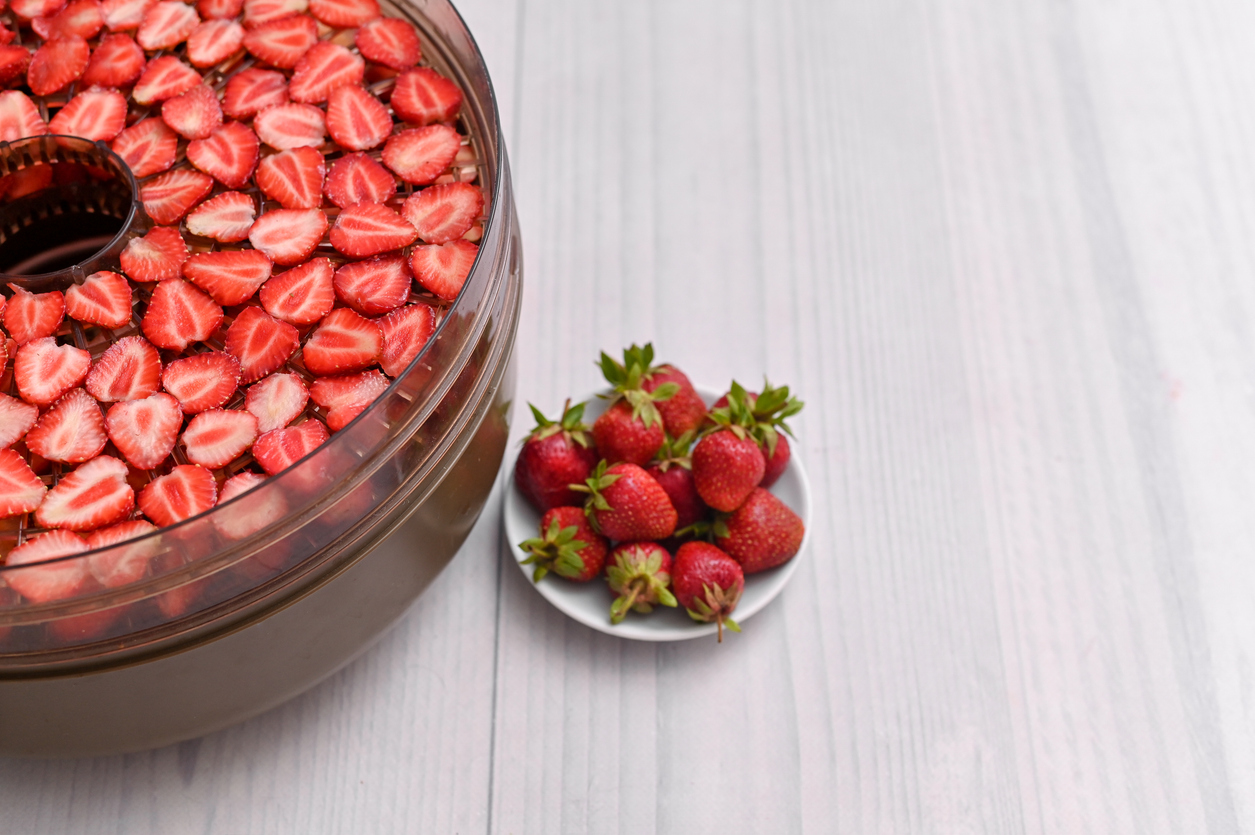
The best way to store strawberries is to keep them cool or frozen. In your fridge, they’ll last about a week if you keep them in an airtight container in a crisper drawer. Keep them dry, and wash them just before using.
You can freeze strawberries uncovered (spread out on a tray so they don’t cluster together into one big block of strawberry ice), and then move them to an airtight container, where they’ll last from several months up to a year.
You can also preserve your berries (think of strawberry jam), although this typically requires a significant amount of sugar. You can dehydrate them, too, either in the sun or using a dehydrator, to create sliced dried strawberries (excellent in granolas and trail mixes) or fruit leathers.
Strawberry Recipes
Strawberries, with their vibrant color and sweet, juicy flavor, are a favorite ingredient that can transform any dish. Whether you’re whipping up a morning smoothie, crafting a decadent dessert, or stirring up some homemade jam, strawberries add a burst of freshness and taste that’s hard to beat. Explore the many ways to incorporate this sweet and juicy fruit into your cooking with our collection of delicious strawberry recipes, perfect for any occasion and season.
1. Strawberry Shortcake Smoothie
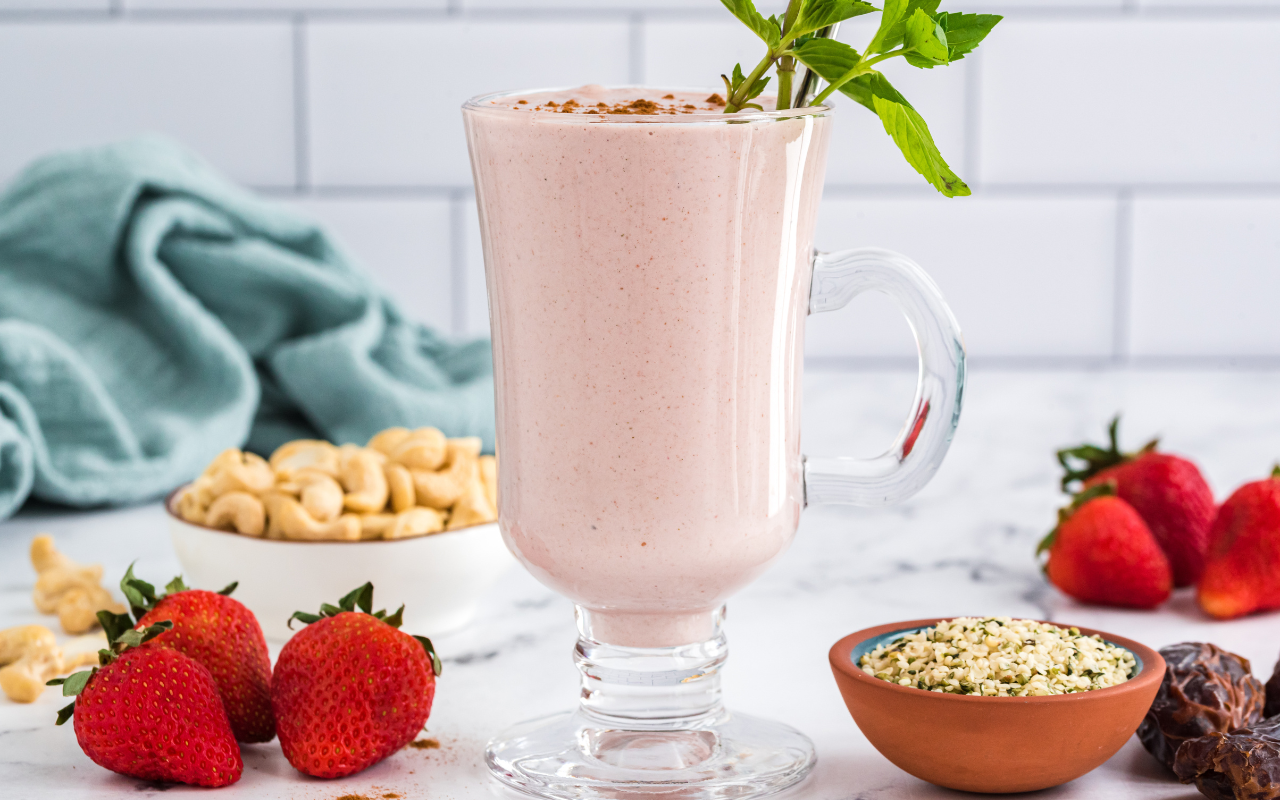
Enjoy the sweet and nostalgic taste of strawberry shortcake with our Strawberry Shortcake Smoothie, where dessert meets nutrition in every sip. This smoothie blends juicy organic strawberries, known for their rich antioxidants and heart-healthy benefits, with creamy cashews for a silky texture. Organic rolled oats and dates bring satisfying fiber and comforting sweetness, while hemp seeds add a protein-packed punch. Infused with a hint of vanilla and a sprinkle of cinnamon and finished with refreshing mint, this smoothie is perfect for a healthy breakfast or a delightful afternoon snack. Enjoy the taste of summer all year round with this naturally sweet, nourishing treat!
2. Strawberry Spinach Salad
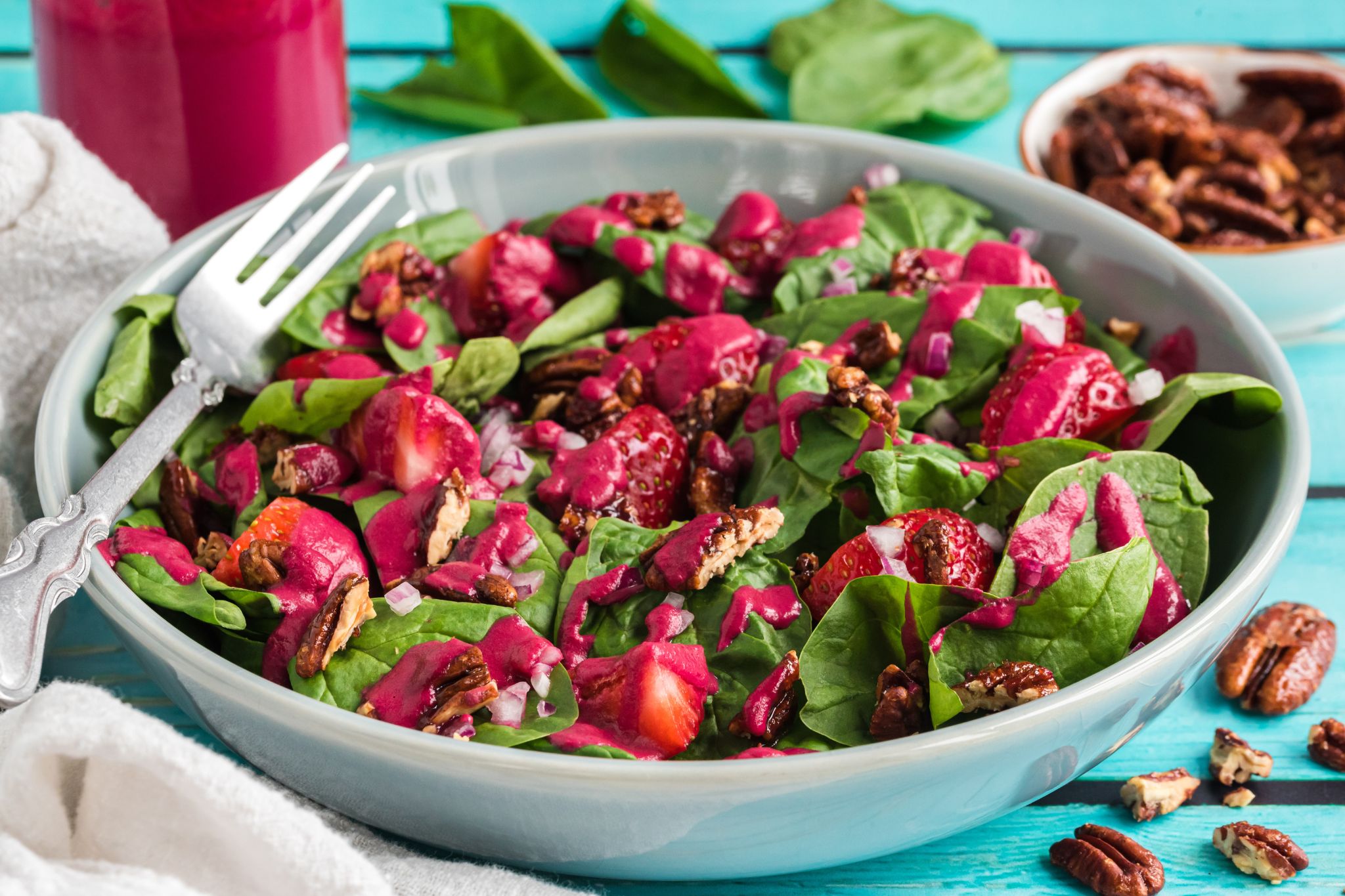
Our Strawberry Spinach Salad is a delightful mix of fresh spinach leaves, juicy strawberries, crunchy pecans, and sharp red onion, all brought together with a unique beet balsamic vinaigrette. The salad’s vibrant red strawberries not only make it visually appealing but also enhance the overall flavor, creating a truly special salad. Perfect as a side for family gatherings or a nutritious solo lunch, you can easily bulk it up with some plant-based proteins or grains to make it even more satisfying.
3. Strawberry Pear Jam
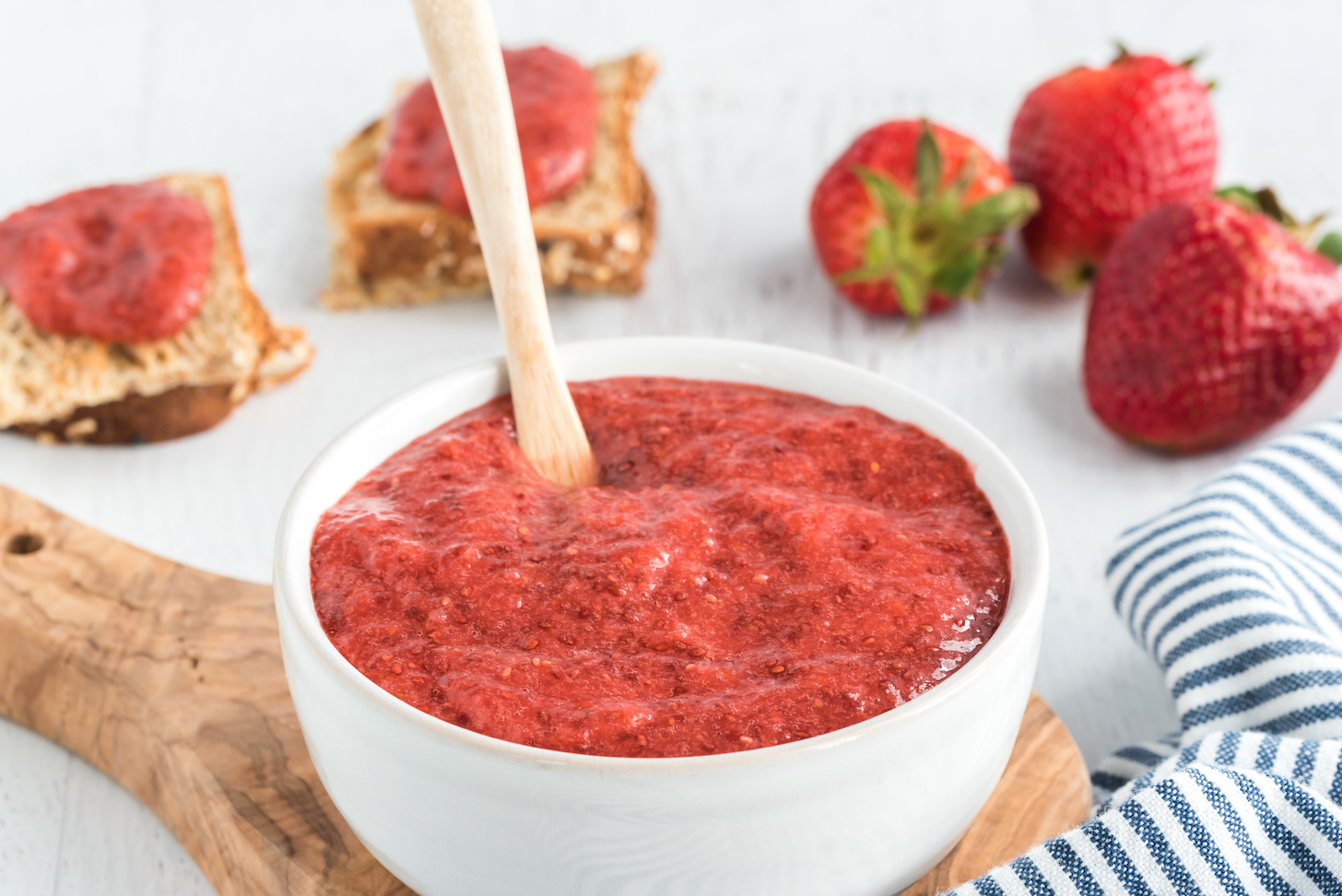
Strawberry lovers, meet your new favorite homemade strawberry jam. This Strawberry Pear Jam is naturally sweet, incredibly delicious, and easy to whip up! Start by simmering strawberries and pears until they reduce into a sweet, juicy mixture. Stir in chia seeds, packed with fiber and omega-3s, to thicken the fruit into a luscious jam. Tip: Double your batch and pack the jam into small mason jars — it’s the perfect way to share this scrumptious spread with family and friends.
So Are Strawberries Worth Eating?
The health benefits of strawberries are noteworthy. However, there are significant environmental impacts and even health concerns to conventionally-grown strawberries grown with pesticides, especially if they are jetted in from faraway countries.
To mitigate risks and negative environmental impacts, do your best to choose organic, locally grown, or frozen strawberries, or grow your own.
And then enjoy them, because they’re berry delicious!
Tell us in the comments:
- Will you continue to, or start, eating strawberries after reading this article? Why or why not?
Featured Image: iStock.com/alvarez

